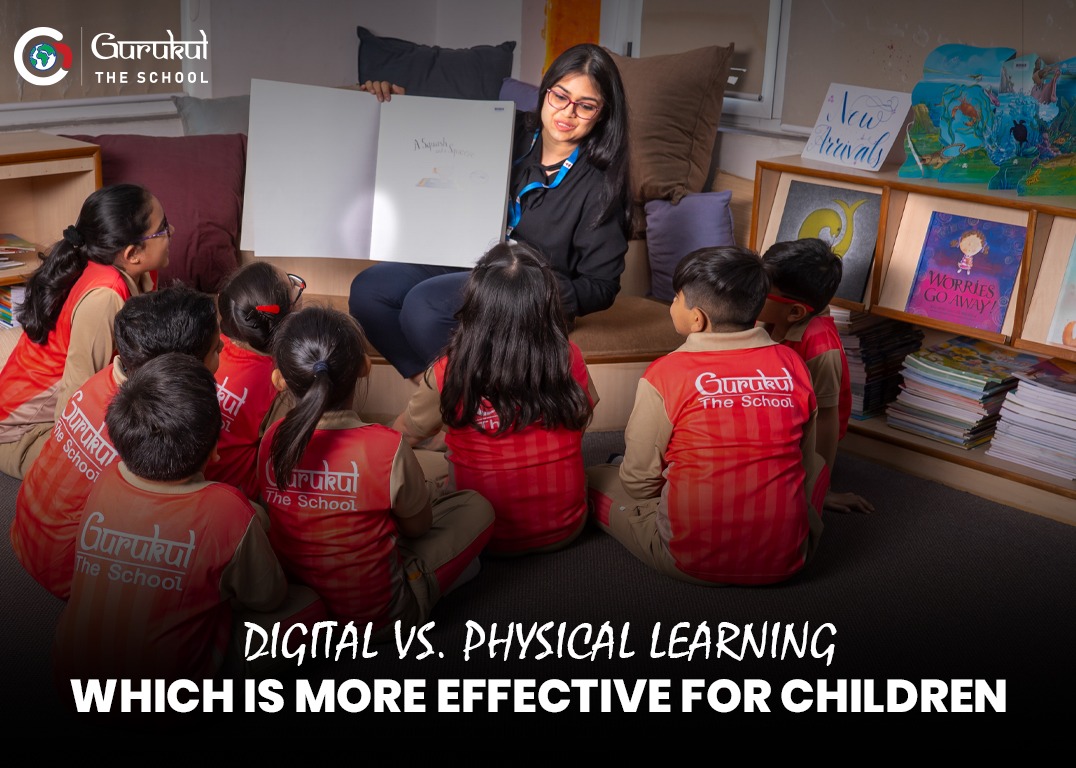Digital vs. Physical Learning: Which is More Effective for Children?
posted on Jan 22, 2025
Gurukul The School believe that the success rate of learning can be ascertained by looking at the student engagement level. This is one area where physical and digital learning walk hand-in-hand

The world of education and learning has transformed drastically. There was a time when learning was only theory-centric. However, in today’s times, learning has become a lot more about combining theory with practical insights. Moreover, academic performance is no longer determined merely based on the marks scored by children in examinations. What has become equally important in today’s times are the skills honed by children. No wonder individual learning needs are being emphasized a lot these days so that every child can learn in a way and at a pace most suited to them. This is where the debate about choosing between digital and physical learning arises.
We at Gurukul The School, best school in ghaziabad list, believe that a mix of both these learning elements is what children need today for their holistic growth and development. Let us look at the reasons that make us say so.
Is it Necessary to Choose Between Physical and Digital Learning?
The 21st century has evolved to a point wherein technology, innovation, artificial intelligence, and machine learning have become our best friends. Does this mean we have forgotten history, started overlooking the criticality of research, and have begun seeing human resources as redundant? Of course not! Instead, what we have been doing is uniting traditional methodologies with modern-day upgrades for optimum outcomes.
The exact same module operates in the case of learning as well. In physical learning, where the teacher and children have a 1:1, concepts from the book are taught in a classroom using a blackboard, there is give and take, and a personal touch is involved, which holds deep meaning.
However, this form of learning remains incomplete if not backed by digital learning, where children get to access additional resources, individual concepts are explained in further detail, and, of course, there are support groups that keep children encouraged beyond school hours.
From this, it is clear that there is actually no need to choose between physical and digital learning because what works best in children's interests is a combination of both these schools of thought. At Gurukul The School, we have united these two ends, and we must say the results surpass our expectations.
Benefits of Merging the Best of Physical and Digital Learning:
- Staying afloat with up-to-date information:
For children to leave a mark on society, it is important that they be well acquainted with up-to-date knowledge and information. This is where the combination of physical and digital learning helps children by not just throwing light on complex concepts (physical learning) but also backing these with new-age examples and developments (digital learning) so that children have all-round clarity into the subject matter at hand.
Combining physical and digital learning adds a ray of flexibility to the process of learning. For example, if a child is unable to attend a class in a physical setup, they can always go back to the class recording, presented digitally. This would ensure that children do not miss day-to-day learning. Who wouldn’t want to enjoy learning flexibility of this kind?
- Room for Personalized Learning:
In the case of physical learning, the teacher has to in person deal with a diverse number of students with different learning needs. Amidst this, challenges arise. For example, every student might not get the attention that is due. Digital learning helps to cover up situations like this, as it comes complete with tools and resources that make customized learning possible.
- Improved Student Engagement:
We at Gurukul The School believe that the success rate of learning can be ascertained by looking at the student engagement level. This is one area where physical and digital learning walk hand-in-hand, with the former opening avenues to group discussions, hands-on activities, and immediate feedback, while the latter focuses on videos, simulations, and quizzes. A deadly combination to student’s learning success.
In terms of costs, accessibility, adaptability, and development of essential skills, again, a combination of physical and digital learning does wonders.
Final Thoughts:
As a parent, if you have been struggling to choose between physical and digital learning for your children, it is time to heave a sigh of relief. What makes us at Gurukul The School, a highly trusted primary school in ghaziabad, say so is the fact that both these learning techniques are independent and beneficial in their own way, ensuring their combination works best.
For instance, physical learning may help a teacher to pass on book-based theory to children. However, if any of the children has a deeper query/question that is outside of the purview of the school curriculum, digital learning can step in to help find answers and address these questions.
With this, we would like to conclude by saying that when you can have both, why settle for just one? Let’s make the new learning era a mix of physical and digital learning. Are you with us on this?